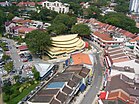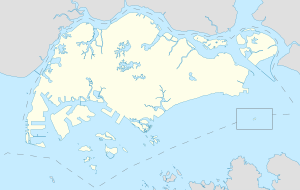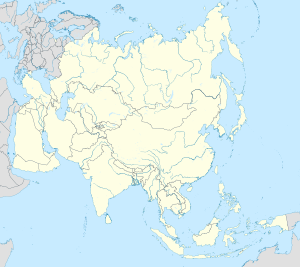Bukit Timah
Bukit Timah | |
|---|---|
| Other transcription(s) | |
| • Malay | Bukit Timah (Rumi) بوکيت تيمه (Jawi) |
| • Chinese | 武吉知马 (Simplified) 武吉知馬 (Traditional) Wǔjí Zhīmǎ (Pinyin) Bú-kit Ti-má (Hokkien POJ) |
| • Tamil | புக்கிட் திமா Pukkiṭ timā (Transliteration) |
From top left to right: National Junior College, Ngee Ann Polytechnic, The Chinese High School Clock Tower Building, Aerial view of the Bukit Timah portion of Holland Village, former Bukit Timah railway station | |
 Location of Bukit Timah in Singapore | |
 Location in Central Region | |
| Coordinates: 1°19′45.88″N 103°48′7.48″E / 1.3294111°N 103.8020778°E | |
| Country | |
| Region | Central Region
|
| CDCs | |
| Town councils |
|
| Constituencies | |
| Government | |
| • Mayors | Central Singapore CDC
North West CDC South West CDC |
| • Members of Parliament | Bishan-Toa Payoh GRC
Holland-Bukit Timah GRC Jurong GRC Tanjong Pagar GRC |
| Area | |
• Total | 17.53 km2 (6.77 sq mi) |
| Population | |
• Total | 83,570 |
| • Density | 4,800/km2 (12,000/sq mi) |
| Ethnic groups | |
| • Chinese | 67,400 |
| • Malays | 640 |
| • Indians | 3,840 |
| • Others | 5,980 |
| Postal districts | 10, 11, 21 |
| Dwelling units | 2,423 |
Bukit Timah (IPA: /ˈbʊkɪt ˌtiːmɑː/ BUUK-it TEE-mah), often abbreviated as Bt Timah, is a planning area and residential estate located in the westernmost part of the Central Region of Singapore. Bukit Timah lies roughly 10 kilometres (6.2 mi) from the Central Business District, bordering the Central Water Catchment to the north, Bukit Panjang to the northwest, Queenstown to the south, Tanglin to the southeast, Clementi to the southwest, Novena to the east and Bukit Batok to the west.
Owing to its prime location, Bukit Timah has some of the densest clusters of luxury condominiums and landed property in the city, with very few public housing.
Etymology
[edit]The last identification of the area was on the 1828 map by Frankin and Jackson and was noted as Bukit Timah.[4] As the interior of Singapore was not fully explored, it is likely the name came from the Malays.[4]
In Malay, Bukit Timah meant Tin bearing hill.[4] The original Malay name was Bukit Temak, meaning "hill of the temak trees" as the temak trees were abundant in the area.[4][5] It was possible that the British in Singapore had mispronounced or misheard and became Bukit Timah.[4]
History
[edit]Bukit Timah Road, was completed in 1843 to provide a link to the highest point of Singapore, the Bukit Timah Hill. The road was then extended northwards to Kranji in 1845, making it one of the earliest roads connecting the north to the south.[6]
The Bukit Timah railway station (BRTS) was one of the five Singapore-Kranji railway stations opened in 1905, the first railway of Singapore. BRTS was decommissioned in July 2011 together with Tanjong Pagar railway station. Sections of the former railway station have been repurposed as a community space, and is now part of the Rail Corridor. [7]
Bukit Timah was a major battleground during the final stages of the Japanese Invasion in 1942, where the Battle of Bukit Timah was fought. The battle resulted in the fall of Bukit Timah to the Japanese as British had failed to repel the invaders from the area.
Beauty World was formerly named Tai Tong Ah Sai Kai which was founded as an amusement park during the Japanese Occupation. Following the end of occupation, Tai Tong Ah Sai Kai was renamed Beauty World in 1947 and reopened as a market. After being badly damaged by series of fires in the 1970s, Beauty World was acquired by the government and was redeveloped as a shopping centre, which opened in 1984.[8]
Infrastructure
[edit]The Bukit Timah area is a particularly prominent location with high land value.
The Bukit Timah Race Course, a thoroughbred horse racing facility, was opened in 1933 and operated until 1999. The land has since been renovated, and is currently home to The Grandstand, which hosts several food outlets, childcare services and a Giant supermarket.[9]
The nearby area hosts many bungalows, typically expensive in land-scarce Singapore, as well as high rise condominiums. Many expatriates and well-heeled Singaporeans live in this region. Its main attractions include popular eateries at Sixth Avenue, as well as Turf City.
This region was later extended and Upper Bukit Timah (District 21) was formed.
Mass Rapid Transit
[edit]There are 7 MRT stations within the planning area, spanning 2 lines, the Downtown Line and Circle Line. Stage 2 of the Downtown MRT line train service started on 27 December 2015 and parallels the Bukit Timah Road. It connects Bukit Panjang in the North-Western edge of Bukit Timah to the city centre in the South. Both lines have an interchange station at Botanic Gardens MRT station. The 6 other stations are:
- DT5 Beauty World
- DT6 King Albert Park
- DT7 Sixth Avenue
- DT8 Tan Kah Kee
- CC20 Farrer Road
- CC21 Holland Village
Education
[edit]Bukit Timah is known to having many international schools in the region, due to the high number of expatriates and immigrants living in this region.
Primary schools
[edit]- Bukit Timah Primary School
- Henry Park Primary School
- Methodist Girls' School (Primary)
- Nanyang Primary School
- Pei Hwa Presbyterian Primary School
- Raffles Girls' Primary School
Secondary schools
[edit]- Anglo Chinese School*
- St Joseph's Institution
- Singapore Chinese Girls School*
- Hwa Chong Institution
- Methodist Girls' School (Secondary)
- Nanyang Girls' High School
- National Junior College
- St. Margaret's Secondary School
- Assumption English School
- Assumption Pathway School
Tertiary Institutions
[edit]- Hwa Chong Institution
- National Junior College
- St Joseph's Institution
- Ngee Ann Polytechnic
- Singapore University of Social Sciences
Other schools
[edit]- Chatsworth International School
- DIMENSIONS International College (Bukit Timah Campus)
- Holland International School
- Hwa Chong International School
- St Francis Methodist School
- Singapore Korean International School
- Swiss School in Singapore
See also
[edit]- Bukit Timah Monkey Man – cryptid said to be living in the Bukit Timah forest
References
[edit]- ^ a b City Population - statistics, maps and charts | Bukit Timah
- ^ HDB Key Statistics FY 2014/2015 Archived 4 March 2016 at the Wayback Machine
- ^ a b "Statistics Singapore - Geographic Distribution - Latest Data". Retrieved 10 January 2025.
- ^ a b c d e Savage, Victor R. (2013). Singapore street names : a study of toponymics. Brenda S. A. Yeoh. Singapore. pp. 129–130. ISBN 978-981-4484-74-9. OCLC 868957283.
{{cite book}}: CS1 maint: location missing publisher (link) - ^ Loi, Rachel (9 September 2017). "Many Sides of Bukit Timah". The Business Times. Retrieved 21 June 2019.
- ^ Chin, See Chung. (1995). Rain forest in the city : Bukit Timah Nature Reserve, Singapore /. Singapore: National Parks Board, Singapore Botanic Gardens. doi:10.5962/bhl.title.77528.
- ^ Singapore, National Library Board. "Bukit Timah Railway Station". www.nlb.gov.sg. Retrieved 21 April 2024.
- ^ "Former Beauty World". www.roots.gov.sg. Retrieved 21 April 2024.
- ^ K.C. Vijayan (17 March 2014). "Court battle over handover of Turf City". AsiaOne. Archived from the original on 29 March 2017. Retrieved 29 March 2017.
Sources
[edit]- National Heritage Board (2002), Singapore's 100 Historic Places, Archipelago Press, ISBN 981-4068-23-3








